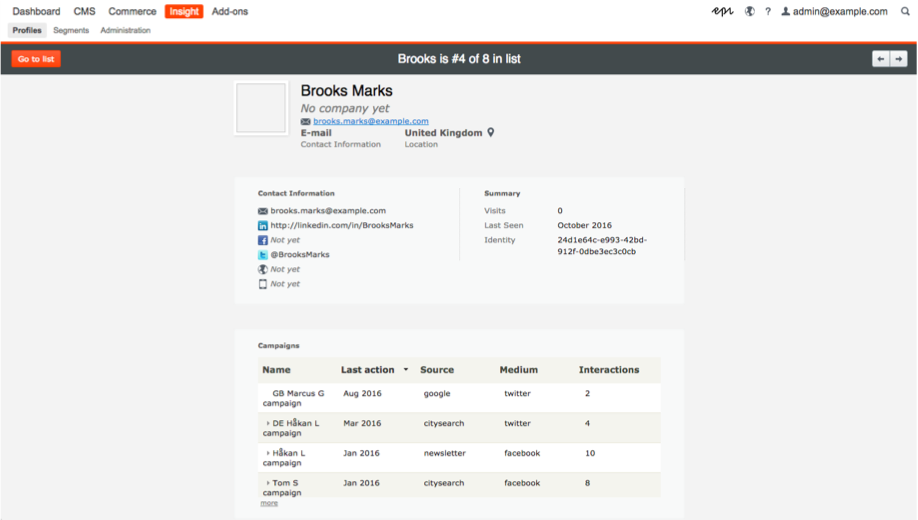New Visitor Intelligence Product & Headless API from Episerver
Episerver Digital Experience Cloud has seen numerous enhancements over the last few years; Episerver Perform, Episerver Advance, Episerver Social, Distributed Order Management System (DOMS), Episerver UGC, and Episerver Commerce for Microsoft Dynamics 365, to name a few. This strong commitment by Episerver to innovating its solution has been recognized by leading market research firms with a high valuation for consumers. One of the most recent recognitions was Episerver’s inclusion in Gartner’s Magic Quadrant for Digital Experience Platforms.
This week, Episerver added two new enhancements to its next-generation content and commerce platform with the launch of Episerver Insight and a new Headless API to “help organizations gain visitor intelligence and deliver more seamless experiences for their customers everywhere they engage.”
Following the announcement, I reached out to Justin Anovick, VP, Product at Episerver, to go  more in-depth on the launch of Episerver Insight and a new Headless API:
more in-depth on the launch of Episerver Insight and a new Headless API:
Due to the ongoing explosion in the volume of data collected, many organizations are living in irony where they gather too much data but know too little about what this data represents. How does the new launch of Episerver Insight address that gap?
Anovick: “It’s easy to collect data now, but much harder to put it in context and make it actionable for your marketing team. Episerver Insight addresses this gap by arming its users with the tools they need to analyze and home in on customer data in a visually coherent way and to then harness that data to personalize each engagement.”
Episerver Insight was first introduced as one of the three additions to Episerver’s Omnichannel Personalization Suite in November 2016. What are the recent enhancements to it since then?
Anovick: “Whereas the initial release was focused on the ability to collect data, the current iteration of Insight provides added context to this data through comprehensive visual intelligence. This means marketers and merchandisers can now visually chart the digital behavior of customers -- both authenticated and anonymous -- from first click to website visit to most recent purchase.”
What is it Episerver wants to achieve with the launch of a new Headless API?
Anovick: “Our aim in introducing a headless API is to provide more flexibility on the front end for organizations’ IT teams while continuing to deliver the same core functions of Episerver’s platform on the backend."
"The plug-in is built using existing technology so that users can easily adopt it for a coupled, decoupled or purely headless approach without drastic changes to their existing platform implementation and without compromising the delivery of rich content and seamless digital experiences.”
Get To Know Your Audience
As the 80/20 rule (aka the Pareto Principle) suggests, 20 percent of your activities will account for 80 percent of your results. If we apply this rule to customer retention, as also Gartner suggests, a staggering 80% of a company’s future revenue will come from just 20% of its existing customers.
Episerver Insight runs algorithmic analytics so users can detect the similarities in the behavior of their big spenders. With the 80/20 rule in mind, that is a very important pattern to capture. As the platform provides a deeper understanding of the target audience using Episerver’s real-time data discovery engine, organizations can pull up any customer to see why they became a customer in the first place. Episerver Insight is designed to address the need for being able to utilize the data collected to effectively increase engagement with customers in a meaningful way. The platform is also configured with Episerver Commerce, Episerver Perform, and Episerver Reach.

When visitors come to a site using different browsers or several devices, it is not uncommon that content management systems create several profiles for one user. In that case, the Profile Store in Epi’s platform detects and merges profiles that correspond to one person based on the user's email address.
Since the acquisition of Peerius, Episerver has been amplifying its integrated real-time predictive analytics powered by machine learning and big data to help its users provide every site visitor with a custom experience. The primary factor behind those enhancements is the high demand for having comprehensive visual intelligence about customer behavior.
Today, it is essential to building greater customer experiences for businesses to adopt some sort of advanced analytics such as prescriptive and predictive analytics as they truly eliminate biased decision making processes by taking the guesswork out of what content to produce and which platform to be on. The difference between prescriptive and predictive analytics is the fact that while predictive analytics is about understanding the future, prescriptive analytics focus more on providing advice.
A Hybrid Approach with the New Headless API
The new Headless API offers a hybrid architecture that supports coupled, decoupled and purely headless scenarios that transcend channels. According to Episerver, the API enables users to pull content directly from the platform and project it into any number of applications.
The concept of a headless content management system has lately been one of the most debatable topics in the content management system industry. Many still discuss whether organizations should go with headless or they should stick with a traditional CMS. Episerver has a unique stand when it comes to a headless CMS approach. In August, I reached out to James Norwood to inquire about his take on this renewed interest in a headless approach.
To be able to provide a headless product, Norwood believes that building a new CMS from scratch is not necessary as long as the core of the WCM platform in place is flexible to respond to an ever-changing delivery paradigm. In fact, for midsize organizations that are aiming to deliver an enterprise-level experience, Norwood suggests a hybrid approach where the platform is built on a decoupled architecture, so organizations can have the option to go headless or traditional (coupled) - or even a combination of the two. Therefore, while Episerver was developing the new headless API, it “has made use of existing stateless REST endpoints and our enterprise search foundation, Episerver Find™, to optimize queries and deliver JSON payloads in an environment that Episerver developers are used to," according to Norwood.
I agree with Norwood on adopting a hybrid approach. At the end of the day, there is no best approach as every organization has their own unique set of challenges and goals. Even the best match to an organization’s current requirements may become a headache tomorrow. It is important to create a nimble and extensible platform ecosystem. There will be times when a pure headless CMS may serve better, and when even a traditional CMS may provide great value so much so that there won’t be necessarily added value in a headless or decoupled CMS.
Guess Who Else Will Be at Ascend 2018?
Last year, my co-worker Laura Myers and I were invited to attend Episerver’s annual user  conference, Ascend 2017, as media, which took place in the glamour of the heart of Las Vegas, with over 600 attendees and more than 70 sessions. Because we brought back with us all the different unique perspectives from the Episerver Community for our audience last year, we will again be at the event this year.
conference, Ascend 2017, as media, which took place in the glamour of the heart of Las Vegas, with over 600 attendees and more than 70 sessions. Because we brought back with us all the different unique perspectives from the Episerver Community for our audience last year, we will again be at the event this year.
For those who are not familiar with the concept of the conference; Ascend is a session-based event where both technical and non-technical folks can find many educational sessions tailored to their interests to dive deeper into the Episerver features and the platform. Last year, we captured the buzz and conversation directly from the event floor by interviewing Epi customers, Ektron customers, seasoned technology partners and Episerver’s leadership. Here are some of our key takeaways from those conversations:
-
No matter if the person we spoke with was a customer or a technology partner; everyone stressed the importance of the same functionality of web content management systems: personalization.
-
All the Epi customers we talked to were so excited to leverage the tools to deliver fully automated and personalized experiences to their own customers and prospects.
-
Another popular Episerver product was Episerver Find, which is Episerver’s search relevance engine. During our conversations, its customers expressed their satisfaction with Episerver Find displaying content automatically selected for each visitor based on visitor profile, interest, or work role.
-
While the features like personalization and product recommendation have been very well-known and heavily used, some customers also indicated their excitement about the adoption of the new features powered by artificial intelligence technologies. However, the common feeling was that they still need a good use case for them.
This year, the conference is taking place at Aria Resort, Las Vegas on March 11-14 2018. Among many, another reason to attend Ascend 2018 will be to join Laura and I to chat with the entire spectrum of the Episerver community. I look forward to finding out which features have become mainstream during the past year and which features still remain on the shelf for a while as well as hearing what has been stored in Epi’s and its customers’ agendas for this year.
If you already know that you are attending this year, send us an email to snag your seat to be part of our educational and entertaining interviews at Episerver Ascend 2018.

Venus Tamturk
Venus is the Media Reporter for CMS-Connected, with one of her tasks to write thorough articles by creating the most up-to-date and engaging content using B2B digital marketing. She enjoys increasing brand equity and conversion through the strategic use of social media channels and integrated media marketing plans.